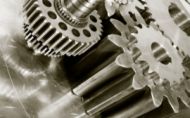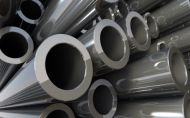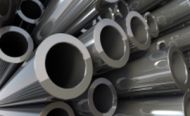Titanium Facts
Titanium is ranked ninth in abundance among the elements in the crust of the earth but is never found in the pure state. It occurs as an oxide in the minerals ilmenite, FeTiO3; rutile, TiO2; and sphene, CaO · TiO2 · SiO2. The world production of titanium compound exceeds 1 million tonnes annually, of which only a small proportion is used in the production of pure titanium metal - about 100,000 tonnes, mainly in Russia, the USA and Japan
Titanium has a density of just 4.505 kg per cubic metre, but combines this metallic "lightness" with a strength, especially in titanium alloys, considerably higher than aluminium alloys and comparable to the best structural steel. Conductivity of heat and electricity is low, and titanium retains its' properties in a range of approximately -270oC to +400oC. At near absolute zero titanium becomes superconductive. At the higher temperature limit, strength diminishes and oxidisation increases, limiting the range of applications at high temperatures. Titanium melts at about 1660° C, boils at about 3287° C. The atomic weight of titanium is 47.9.
High Reactivity
Chemically, titanium is distinguished by its high reactivity, which is only surpassed by metals such as magnesium, calcium and sodium. That titanium can be employed under circumstances where most other structural material would be subject to severe corrosion is due to the properties of its oxide, TiO - it is highly resistant and forms a self-healing coating which is normally only about 0.01 mm thick. If the coating is damaged and the environment contains oxygen in some form, the titanium and oxygen react and rebuilds the oxide. In deoxidised or reduction environments, the oxide protection is weakened and the metal becomes exposed to corrosion. Thus where resistance to corrosion is required, the resistance can often be improved through the introduction of an oxidation agent into the application environment.

Because of its strength and light weight, titanium is used in metallic alloys and as a substitute for aluminium. Alloyed with aluminium and vanadium, titanium is used in aircraft for fire walls, outer skin, landing-gear components, hydraulic tubing, engine supports, compressor blades, discs, and housings of jet engines.

Titanium is also widely used in missiles and space capsules; the Mercury, Gemini, and Apollo capsules were made largely of titanium. The relative inertness of titanium makes it available as a replacement for bone and cartilage in surgery and as a pipe and tank lining in the processing of foods. It is used in heat exchangers in desalination plants because of its ability to withstand salt-water corrosion. In metallurgy, titanium alloys are employed as deoxidizers and denitrogenizers to remove oxygen and nitrogen from molten metals.
Properties

- Titanium - Chemical and Mechanical properties
- Design stress values at 20oC and higher
- Comparative values
